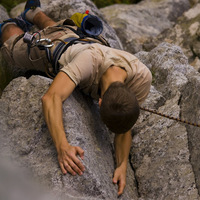The immune system provides vital protection against pathogens, but extensive evidence suggests that mounting immune responses can entail survival and fecundity costs. The physiological mechanisms that underpin these costs remain poorly... more
The immune system provides vital protection against pathogens, but extensive evidence suggests that mounting immune responses can entail survival and fecundity costs. The physiological mechanisms that underpin these costs remain poorly understood, despite their potentially important role in shaping life-histories. Recent studies involving laboratory models highlight the possibility that oxidative stress could mediate these costs, as immune-activation can increase the production of reactive oxygen species leading to oxidative stress. However, this hypothesis has rarely been tested in free-ranging wild populations, where natural oxidative statuses and compensatory strategies may moderate immune responses and their impacts on oxidative status. Furthermore, the possibility that individuals scale their immune responses according to their oxidative status, conceivably to mitigate such costs, remains virtually unexplored. Here, we experimentally investigate the effects of a phytohaemagglut...
Research Interests:
ABSTRACT 1. Oxidative stress has been proposed as a key mediator of life-history trade-offs, yet the social factors that affect patterns of oxidative status amongst individuals in animal societies remain virtually unexplored. 2. This is... more
ABSTRACT 1. Oxidative stress has been proposed as a key mediator of life-history trade-offs, yet the social factors that affect patterns of oxidative status amongst individuals in animal societies remain virtually unexplored. 2. This is important, as rank-related differences in reproductive effort in many social species have the potential to generate, or indeed arise from, differences in oxidative status across dominance classes. 3. Here, we examine rank-related variation in oxidative status before and after a lengthy breeding season in a wild cooperatively breeding bird with high reproductive skew, in the semi-arid zone of Southern Africa; the white-browed sparrow weaver (Plocepasser mahali). 4. Our findings reveal that prior to breeding, neither sex showed rank-related differences in markers of oxidative damage or antioxidant protection, suggesting that dominants' reproduc-tive monopolies do not arise from superior pre-breeding oxidative status. 5. After breeding, however, females (who provision young at higher rates than males) suffered elevated oxidative damage, and dominant females (the only birds to lay and incubate eggs, and the primary nestling provisioners) experienced differential declines in antioxidant protection. 6. While males also showed reduced antioxidant capacity after breeding, this decline was not dependent on rank and not associated with elevated oxidative damage. 7. Our findings suggest that divisions of labour in animal societies can leave the hardest-work-ing classes differentially exposed to oxidative stress, raising the possibility of hitherto unexplored impacts on health and ageing in social species.
Research Interests:
Research Interests:
In many cooperatively breeding species, females mate extra-group, the adaptive value of which remains poorly understood. One hypothesis posits that females employ extra-group mating to access mates whose genotypes are more dissimilar to... more
In many cooperatively breeding species, females mate extra-group, the adaptive value of which remains poorly understood. One hypothesis posits that females employ extra-group mating to access mates whose genotypes are more dissimilar to their own than their social mates, so as to increase offspring heterozygosity. We test this hypothesis using life history and genetic data from 36 cooperatively breeding white-browed sparrow weaver (Plocepasser mahali) groups. Contrary to prediction, a dominant female's relatedness to her social mate did not drive extra-group mating decisions and, moreover, extra-group mating females were significantly more related to their extra-group sires than their social mates. Instead, dominant females were substantially more likely to mate extra-group when paired to a dominant male of low heterozygosity, and their extra-group mates (typically dominants themselves) were significantly more heterozygous than the males they cuckolded. The combined effects of mating with extra-group males of closer relatedness, but higher heterozygosity resulted in extra-group-sired offspring that were no more heterozygous than their within-group-sired half-siblings. Our findings are consistent with a role for male-male competition in driving extra-group mating and suggest that the local kin structure typical of cooperative breeders could counter potential benefits to females of mating extra-group by exposing them to a risk of inbreeding.
Research Interests:
Research Interests:
Research Interests:
In many cooperatively breeding species, females mate extra-group, the adaptive value of which remains poorly understood. One hypothesis posits that females employ extra-group mating to access mates whose genotypes are more dissimilar to... more
In many cooperatively breeding species, females mate extra-group, the adaptive value of which remains poorly understood. One hypothesis posits that females employ extra-group mating to access mates whose genotypes are more dissimilar to their own than their social mates, so as to increase offspring heterozygosity. We test this hypothesis using life history and genetic data from 36 cooperatively breeding white-browed sparrow weaver (Plocepasser mahali) groups. Contrary to prediction, a dominant female's relatedness to her social mate did not drive extra-group mating decisions and, moreover, extra-group mating females were significantly more related to their extra-group sires than their social mates. Instead, dominant females were substantially more likely to mate extra-group when paired to a dominant male of low heterozygosity, and their extra-group mates (typically dominants themselves) were significantly more heterozygous than the males they cuckolded. The combined effects of mating with extra-group males of closer relatedness, but higher heterozygosity resulted in extra-group-sired offspring that were no more heterozygous than their within-group-sired half-siblings. Our findings are consistent with a role for male-male competition in driving extra-group mating and suggest that the local kin structure typical of cooperative breeders could counter potential benefits to females of mating extra-group by exposing them to a risk of inbreeding.
